Top Chillers Manufacturer in World
LNEYA is a professional chiller equipment manufacturer, which has been focusing on the research, development and sales of refrigeration equipment for many years. The lowest temperature control equipment of the refrigeration chiller can reach -150°C, and the temperature control accuracy is ±0.1°C ~ ±0.5°C. Refrigeration equipment is widely used in pharmaceutical, chemical, biological, laboratory, research institute, college, medical treatment, hospital, automobile testing and semiconductor testing fields. Our products are sold all over the world.
Customized Solutions For Your Business
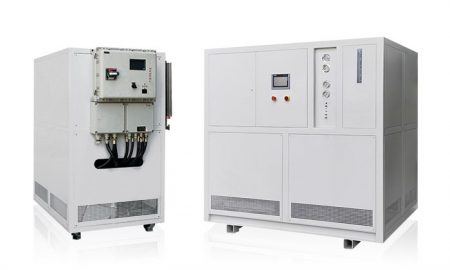
Low Temperature Chillers (Water Cooled or Air Cooled)
Ultra-low temperature cascade refrigeration technology.
Each temperature segment has more than a dozen product models for you to choose from.
| Temperature range | -25°C ~ -5°C series | -45°C ~ -10°C series | -60°C ~ -10°C series | -80°C ~ -30°C series | -110°C ~ -50°C series | -150°C ~ -110°C series |
| Cooling Capacity | 3 ~ 103 Ton | 1.5 ~ 103 Ton | 1.5 ~ 103 Ton | 1.1 ~ 77 Ton | 0.5 ~ 52 Ton | 0.7 ~ 3.2 Ton |
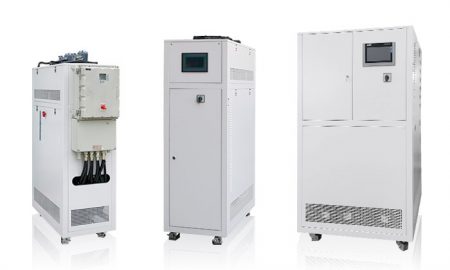
Recirculating Chillers (Water Cooled or Air Cooled)
Closed circulation pipeline, ethylene glycol mixed with water for refrigeration.
| Temperature range | -25°C ~ +30°C series | -45°C ~ +30°C series | -60°C ~ -20°C series | -80°C ~ -20°C series | -120°C ~ -70°C series |
| Cooling Capacity | 0.2 ~ 11 Ton | 0.1 ~ 3.5 Ton | 0.1 ~ 2.1 Ton | 0.05 ~ 2.1 Ton | 0.08 ~ 2.5 Ton |
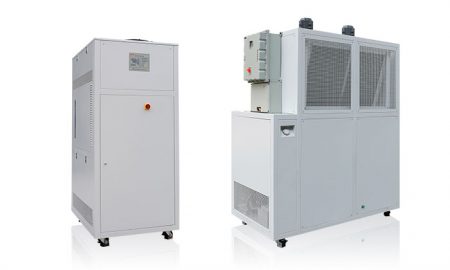
Room Temperature Chillers / Small Chillers
High-precision refrigeration temperature control system.
| Temperature range | -18°C ~ +30°C | +5°C ~ +35°C series |
| Cooling Capacity | 0.09 ~ 0.26 Ton | 0.5 ~ 15 Ton |
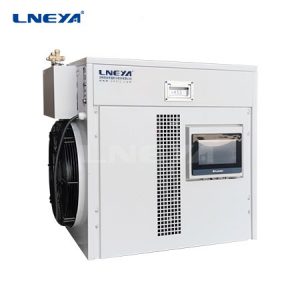
Direct Cooling Type Refrigeration Equipments
It is suitable for places with small heat exchange area and large heat exchange.
| Temperature range | -40°C ~ -10°C | -80°C ~ -35°C | -120°C ~ -90°C |
| Compressor Power | up to 8HP | up to 8HP*2 | up to 45HP*3 |

Direct Cooling Ultra Low Temp Chillers
The ultra-low temperature direct cooling chiller adopts the secondary subcooling technology, and the cooling speed is fast. The refrigerant in the refrigeration system is directly output and evaporated into the target control element (heat exchanger) for cooling.
| Temperature range | -150°C ~ -110°C |
| Cooling Capacity | up to 11kW |
Special Chillers
Chillers For Automotive
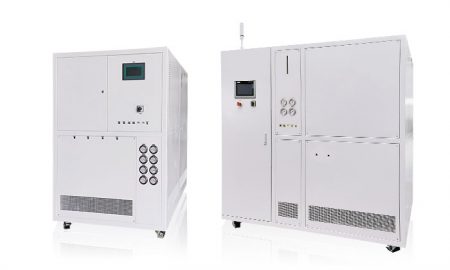 Heat/Cool Temperature & Flow Control Systems
Heat/Cool Temperature & Flow Control Systems
Temperature simulation for vehicle quality test: battery life test, fuel injector/motor test bench, airbag test, component test bench, etc.
| Temperature range | -25°C ~ +100°C | -40°C ~ +100°C | 0°C ~ +100°C | -40°C ~ +135°C |
| Cooling Capacity | 2.8 ~ 38kW | 1.2 ~ 60kW | 1.8 ~ 60kW | 4 ~ 60kW |
Temperature / Pressure / Flow can be independently controlled.
1&2: one machine for two groups control.
| Temperature range | -40 ~ +100℃ 1&2 | 0 ~ +100℃ 1&2 |
| Cooling Capacity | 1.8kW*2 ~ 60kW*2 | 1.8kW*2 ~ 60kW*2 |
Temperature remains constant, pressure / flow can be independently controlled.
1&3: one machine for three groups control.
1&6: one machine for six groups control.
| Temperature range | -40 ~ +100℃ 1&2 | -40 ~ +100℃ 1&3 | -40 ~ +100℃ 1&6 | -20 ~ +100℃ 1&6 | 0 ~ +100℃ 1&2 | 0 ~ +100℃ 1&3 | 0 ~ +100℃ 1&6 |
| Cooling Capacity | 2.5 ~ 60kW | 4 ~ 60kW | 10 ~ 60kW | 10 ~ 60kW | 7 ~ 60kW | 11 ~ 60kW | 18 ~ 60kW |
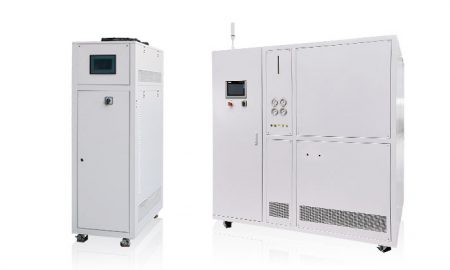
Oil Chillers
| Temperature range | 0℃ ~ +160℃ | +5℃ ~ +135℃ |
| Cooling Capacity | 11 ~ 60kW | 15 ~ 38kW |
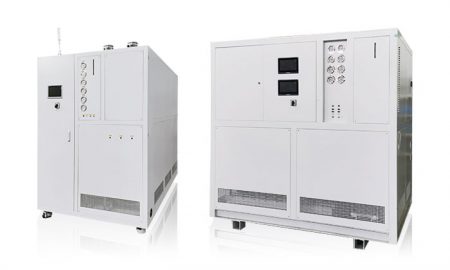
Cooling & Heating Systems For Electronic Pump
| Temperature range | -40°C ~ +135°C |
| Cooling Capacity | up to 60kW |
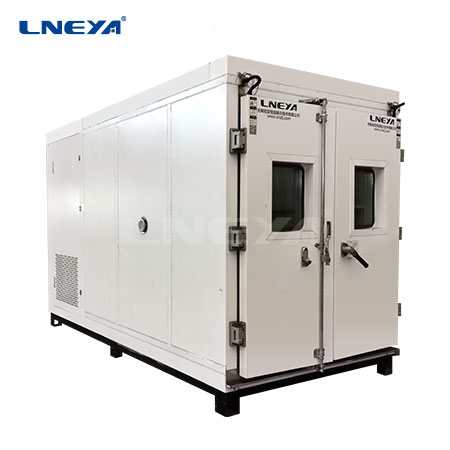
High Low Temperatuer Battery Test Chamber
| Temperature range | -40℃ ~ +100℃ | -40℃ ~ +100℃ |
| Cooling Capacity | 1.8 ~ 7.5kW | 4 ~ 15kW |
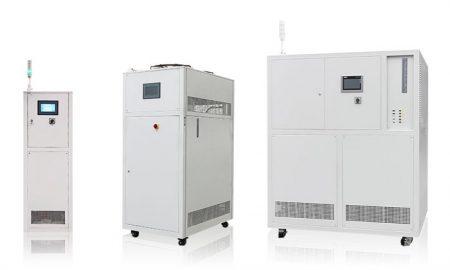
Automotive Direct Cooling Or Heating Systems
| Types | Direct Cooling | Direct Cooling & Heating |
| Cooling Capacity | 5 ~ 10kW | 5 ~ 10kW |

Liquid Cooling For Battery Energy Storage Systems
| Types | For Converting Station | For Energy Storage Battery | For Charging Station |
| Cooling Capacity | 45kW | 5 ~ 8.5kW | 4kW |
Chillers For Semiconductor
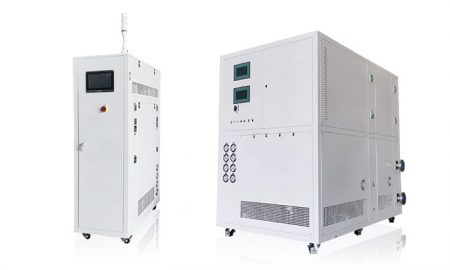
TES Series
Suitable for precise temperature control of semiconductor industry
| Temperature range | -45°C ~ +250°C series | -85°C ~ +200°C series | -60°C ~ +200°C series |
| Cooling Capacity | 0.3 ~ 25kW | 0.25 ~ 25kW | 3 ~ 60kW |
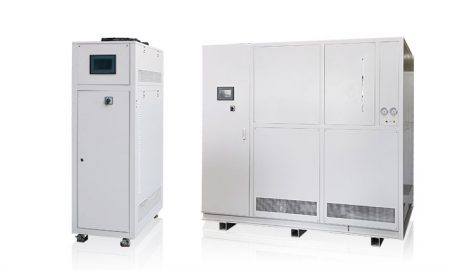
LTS Series (Fluorinated Liquid)
Widely used in the semiconductor manufacturing process to control the temperature of the reaction chamber, the temperature of the heat sink, and the temperature control of the non-flammable fluid of the heat transfer medium.
| Temperature range | -20°C ~ +80°C series | -45°C ~ +80°C series | -60°C ~ +80°C series | -80°C ~ +80°C series |
| Flow Control | 7 ~ 45 L/min | 7 ~ 45 L/min | 7 ~ 45 L/min | 7 ~ 45 L/min |
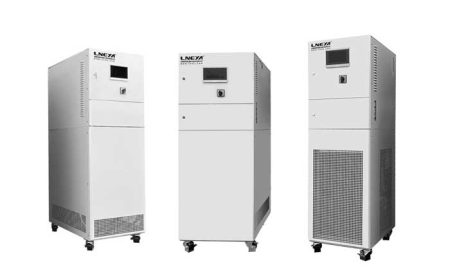
FLT Series
The chiller is mainly used for precise temperature control in the semiconductor production process and testing process.
| Temperature range | +5°C ~ +40°C | -25°C ~ +40°C | -45°C ~ +40°C | -80°C ~ +80°C | -100°C ~ +80°C |
| Cooling Capacity | 6 ~ 40kW | 2 ~ 15kW | 1 ~ 8kW | 0.6 ~ 3kW | 1.5 ~ 3kW |

FLTZ Series Frequency Conversion
Double frequency conversion series temperature control system, circulation pump and compressor are all adjusted by frequency conversion.
| Temperature range | -30°C ~ +40°C |
| Cooling Capacity | 5 ~ 11kW |
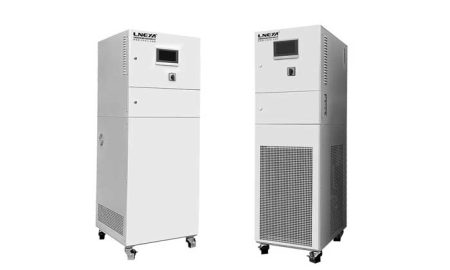
ETCU Series
Heat exchange type. System without compressor
| Temperature range | +5°C ~ +90°C |
| Cooling Capacity | 5 ~ 30kW |

ZLFQ Series
Coolant Distribution Unit
Liquid cooling equipment is suitable for semiconductor testing, electronic equipment constant temperature testing, cooling server supporting infrastructure, and other fluid temperature control places.
| Temperature range | +5°C ~ +35°C | +5°C ~ +35°C |
| Cooling Capacity | 15 ~ 150kW | 200 ~ 500kW |

MD Thermal Chucks Series
It is used for testing RF devices and high-density power devices (IGBTs and MOSFETs), and can also be used for rapid cooling of laboratory flat panels (plasma, biological products, batteries), etc.
| Temperature range | -75°C ~ +225°C |
| Temperature accuracy | ±0.1℃ |
Gas Chillers
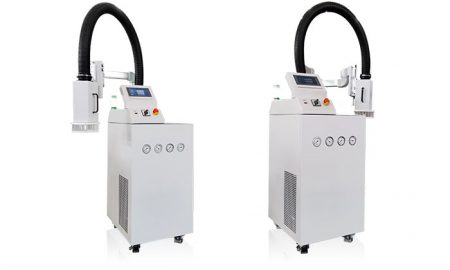
AES Series Jet Impact Testing Machine
Temp Control Range: -120°C ~ +225°C
Application: Research Institute, Aerospace, Semiconductor and Electrical Industry, Optical Communications, University, New Materials Industry, IC Chip Testing, Circuit Board, Component Testing, and Other Fields.
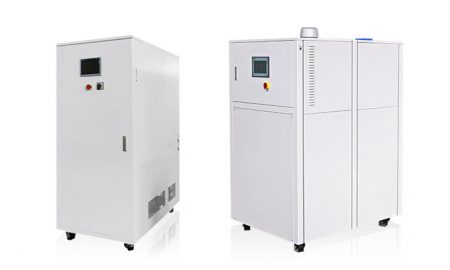
AI Series Recirculating Air Temperature Control System
Temp Control Range: -105°C ~ +125°C
Application: Research Institute, Aerospace, Semiconductor and Electrical Industry, Military Industry, University, New Materials Industry, IC Chip Testing, Circuit Board, Component Testing, and Other Fields.
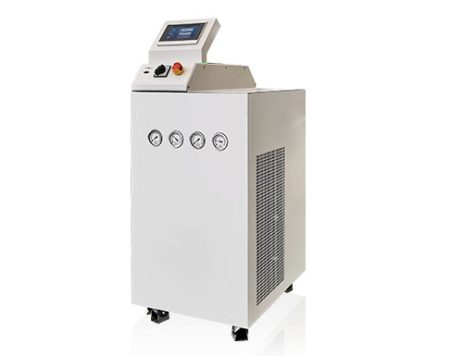
LQ Series Gas Refrigeration System
Temp Control Range: -110°C ~ -40°C
Application: Research Institute, Aerospace, Semiconductor and Electrical Industry, Military Industry, University, New Materials Industry, IC Chip Testing, Circuit Board, Component Testing, and Other Fields.
YQH Series VOCs Waste Gas Condensation Recovery Device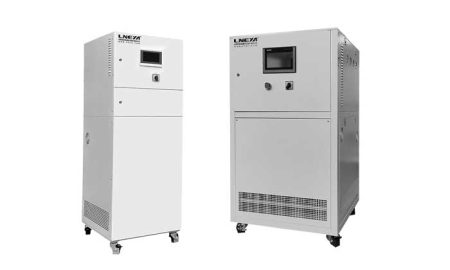
Applied to gas condensation liquefaction recovery. The exhaust gas or other electronic gases are connected to the equipment through the induced draft fan (vacuum pump), liquefied, collected and separated into the collection tank by lowering the temperature, and other gases are discharged, so as to realize the condensation, capture and recovery of the gas.
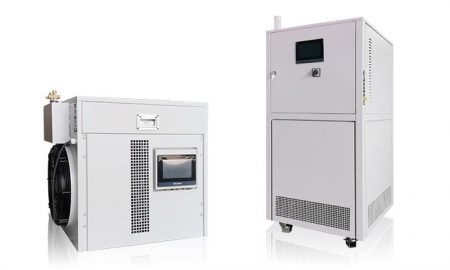
ZLJ / SLJ Series
It is suitable for places where the heat exchange area of the heat exchanger is small but the heat exchange capacity is large. It can also be used for gas capture, the refrigerant is directly passed into the trap to evaporate, and the gas in the space is quickly captured through the condensation effect on the surface of the trap.
| Temperature range | -40°C ~ -15°C | -80°C ~ -50°C | -150°C ~ -110°C |
| Cooling Capacity | 0.5 ~ 4kW | 0.37 ~ 3.1kW | 2.5 ~ 9kW |
| ZLJ Series | SLJ Series | ||
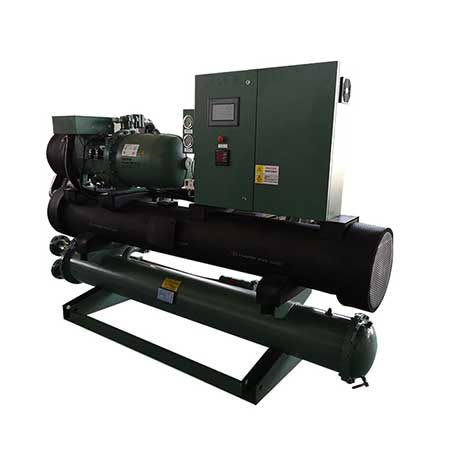
Screw Chillers (Custom Designs)
Low temperature screw chillers and room temperature screw chillers
| Temperature range | +5°C ~ +30°C | +5°C ~ +30°C | +5°C ~ +30°C | +5°C ~ +30°C | -25°C ~ +5°C | -25°C ~ +5°C |
| Cooling Capacity | 107 ~ 1027kW (Single Compressor) | 299 ~ 2134kW (Dual Compressor) | 98 ~ 934kW (Single Compressor) | 272 ~ 1940kW (Dual Compressor) | 48 ~ 467kW (Single Compressor) | 51 ~ 497kW (Single Compressor) |
Contact Us For More Chiller Information
Email: info@lneya.com WeChat ID: +8615251628237 WhatsApp: +86 17851209193
Why choose us as your chiller manufacturer and supplier?
We are a professional manufacturer and supplier of temperature control equipment. The temperature control range of the products is very wide. The minimum control temperature can reach -152°C, and the maximum control temperature can reach +350°C. We support customized product services. For decades, it has provided precise temperature control solutions for various industries, and has won unanimous praise from domestic and foreign customers.
Our company has dozens of high-quality designers and a number of professional R&D teams, with rich experience in the development, research and production of ultra-low temperature and refrigeration and heating integrated systems. Among them, the SUNDI series heating and cooling integrated machine is our classic product. The ultra-wide temperature range from -120°C to 300°C can basically meet the temperature control needs of any industry. More than 100 product models, cooling/heating power, and power supply power are available for you to choose from. At the same time, it also supports customized design and provides you with temperature control solutions for free.
At present, the company is at the advanced level in the same industry in the research and development of single-unit cascade refrigeration technology, and the rapid heating and cooling technology research of integrated refrigeration and heating equipment is at the international advanced level. In particular, the high-precision temperature control of the reactor adopts an internationally advanced single medium to achieve continuous temperature control from -90°C to +250°C, and the high-precision linear control of the temperature of the reactor material.
Advantages of our chillers
- The ultra-wide temperature control range can meet the temperature requirements of different industries.
- Secondary sub-cooling technology is adopted, with fast refrigeration speed.
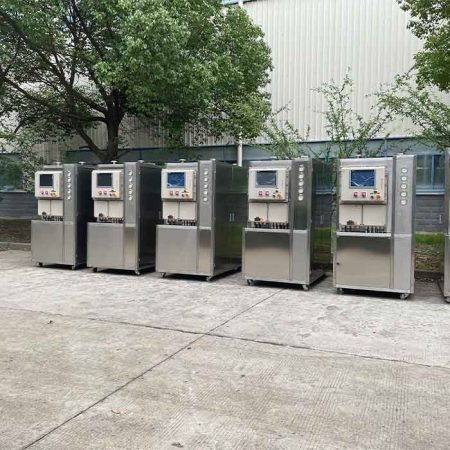
- Imported semi closed piston compressor, semi closed piston two-stage compressor and semi closed screw compressor are adopted. The evaporator adopts high force plate heat exchanger, which has small volume and high efficiency.
- A full set of imported cold controls (Danfoss pressure controller, balance valve, expansion valve, solenoid valve, drying filter, Emerson oil separator, check valve, etc.) are adopted.
- Danfoss electronic expansion valve is adopted with high control accuracy.
- Siemens PLC S7-200 / 300 controller, LNEYA touch screen display, automatic control and operation, temperature curve display, temperature record can be exported to USB flash disk, fault alarm record and other functions are adopted.
- The large refrigerating capacity equipment adopts semi closed screw compressor with economizer operation, which is combined with electronic expansion valve to ensure high efficiency and energy saving.
- Factory test: the load test of each equipment in the factory shall not be less than 12 hours.
What is a chiller?
A chiller is a cooling system that removes heat by circulating heat-absorbing a refrigerant through a series of mechanisms through which the heat is released. The essential components of a chiller are a compressor, condenser, expansion valve, and evaporator. They work in unison to circulate a refrigerant that removes heat from a process, operation, or space.
There are several different types of chillers, each of which has a different process for removing heat. All chillers use air or water as a cooling method. For example, air cools a chiller system using fans, while a water-cooled chiller circulates water with a cooling tower.
Aside from the two cooling processes, chillers are further differentiated by the type of compressor they have. Compressors in all chillers have the same function: to compress the refrigerant and increase its temperature and pressure before it moves on to the condenser.
How does a chiller work?
The whole working principle process of industrial water chiller can be roughly divided into three parts: water circulation system, refrigeration circulation system and main control system. The water circulation system is also a part that directly reflects the function of the industrial water chiller. It transmits the cold water to the equipment that needs to be cooled, and the cold water absorbs the heat of the equipment and then transmits it back. The refrigeration cycle system is a process of cooling the cold water that absorbs heat. The refrigerant sublimates and then compresses to bring the heat in the cold water to the outside for dissipation. The main control system is the part of power control and internal structural components control.
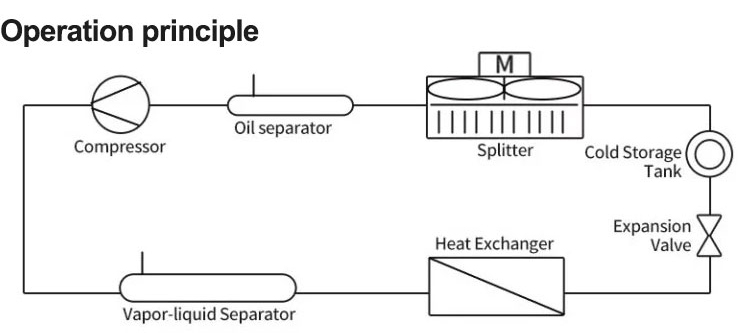
The main components of the chiller
Industrial water chiller consists of compressor, condenser, evaporator, expansion valve and other accessories.
- Compressor: in the industrial water chiller system, the compressor is the power to ensure refrigeration. The compressor is used to increase the pressure of the refrigerant in the system and make the refrigerant circulate in the refrigeration system to achieve the purpose of refrigeration.
- Condenser: high temperature and high pressure Freon of the refrigeration system enters the condenser after coming out of the compressor, releases a lot of heat to the cooling medium, and then is cooled and liquefied.
- Evaporator: when the Freon liquid of the refrigeration system enters the expansion valve for throttling and is sent to the evaporator, it belongs to the vaporization process. At this time, it needs to absorb a lot of heat to gradually reduce the valence and mass temperature to achieve the effect of refrigeration and cooling.
- Expansion valve: in the refrigerant system flow chart of the industrial water chiller, we found that there is a small part between the outlet of the condenser and the inlet of the evaporator, which is called thermal expansion valve. It is a throttling and depressurizing part to reduce the condensation pressure of the refrigerant to the evaporation pressure. Therefore, its role in the refrigeration system is essential. It is connected with the refrigeration compressor, evaporator, condenser It is also called the four components of the refrigeration system.
- Other accessories: including drying filter and high and low pressure controller. The drying filter is non detachable. The internal structure adopts molecular sieve structure, which can remove a small amount of impurities and water in the pipeline, so as to purify the system. The high and low pressure controller plays a protective role in the refrigeration system.
How to calculate the cooling capacity of the chiller?
The basic formula for calculating cooling capacity is as follows:
Q= C*M*ΔT
M is the weight of cooling material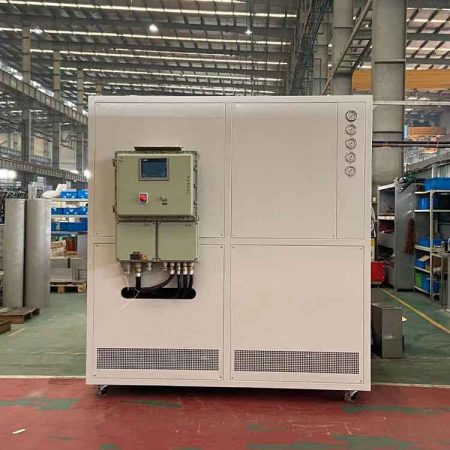
C is the specific heat of the material
ΔT is the temperature difference before and after cooling, that is, the required temperature drop
Collect relevant data:
1. Understand the weight or volume and specific heat of the material. The material is the object to be cooled.
2. In production, whether there is heat generated, if so, record the time and temperature curve.
3. Pay attention to the name of the unit when calculating.
1KW=860Kcal/h
1M³=1000L=1000KG (water)
1KJ/KG℃=0.2389Kcal/h
4. Calculation example:
1M³ of water drops from 20°C to 10°C
1M³=1000L=1000KG
Specific heat of water: 4.19 J/(kg·℃)
Q=1000*4.19*10=419000J converted into power is 11.7KW.
That is to say, for 1M³ of water to drop from 20°C to 10°C within one hour, 11.7KW cooling capacity is required. If it takes 2 hours, then it is 5.85KW.
Why do you need a chiller?
Industrial chillers are refrigeration equipment that use refrigeration and constant temperature water circulation systems to cool in industrial production and scientific experiments. They are generally called chillers or industrial refrigeration equipment. Using equipment refrigeration, inject a certain amount of tap water or pure water, softened water, antifreeze and other refrigerants into the circulating water storage tank of the industrial chiller, cool the refrigerant through the refrigeration system of the industrial chiller, and then cool the low temperature The brine is transported to the production or experimental equipment through the circulation pump for cooling. The brine of the industrial chiller will take away a large amount of heat generated by the equipment, flow back to the water tank after the temperature rises, and then cool the brine through the refrigeration system.
As long as the equipment is working, heat will be generated, and the heat may cause the production equipment and experimental equipment to lose their performance, seriously affect the normal operation of the equipment, and endanger the service life of the equipment. Therefore, it can be said that all production enterprises can use industrial chillers. Of course, enterprises in different industries have different requirements for the specific use of industrial chillers. When choosing industrial chillers, many companies will consider the production environment, investment benefits and operating costs, as well as the special requirements of refrigerants. These are the basic common sense that companies should know when choosing industrial chillers.
How to choose the right chiller?
1. Chiller cooling and stand-alone cooling capacity.
The size of the cooling capacity of the chiller, the energy consumption of the whole unit and the economic benefits of operation, it is not recommended to set up a single chiller in the design of the cold station. Because when a chiller fails, production will not be interrupted, so it is necessary to design a reasonable number of chillers based on the actual production situation.
2. Consider the temperature requirements of the enterprise.
The level of temperature is very important to the selection of chillers and system configuration. It needs to be used in refrigeration equipment in production, scientific research, and life. During the use of chillers, some refrigerants are toxic, irritating, flammable, etc. Refrigerants may destroy the ozone layer in the atmosphere, destroy the human living environment to a certain extent, and bring harm to humans. Therefore, when users choose, it is best to choose environmentally friendly refrigerants.
3. Chiller power consumption and steam consumption.
Considering the energy utilization of large-scale industrial chillers comprehensively, the large-scale air-conditioning station for cooling must fully consider the comprehensive utilization and balance of electricity, heat, and cold, and make full use of waste steam and waste heat to achieve the best economic benefits.
4. Cooling water quality.
Water quality has a great impact on heat exchangers. Poor water quality will reduce the cooling capacity of industrial chillers and cause blockage and damage to heat pipes.
Choose different types of chillers according to the use occasions, such as factories and hospitals with high cooling requirements, hotels and office buildings with high noise requirements, and family residences with strong suitability, and comprehensive consideration and purchase.
Types of chillers
1. By compressor type
Chillers can be divided into piston chillers, scroll chillers, screw chillers, and centrifugal chillers.
2. According to cooling capacity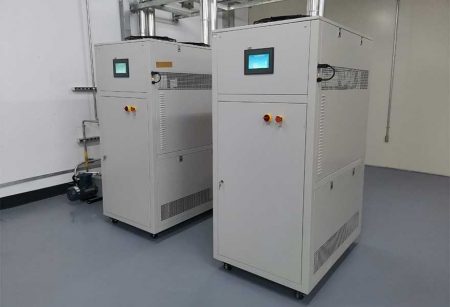
Chillers can be divided into small chillers, medium chillers, and large chillers.
3. According to the heat dissipation method
The chiller is to dissipate the heat of the equipment that needs to be cooled to the outdoor air by consuming electricity, so industrial chillers can be divided into air-cooled chillers and water-cooled chillers.
4. According to the outlet water temperature
Different equipment has different cooling requirements, and the required outlet water temperature is also different, so chillers can be divided into normal temperature chillers, low temperature chillers and ultra-low temperature chillers.
5. According to the use environment
Due to different environments, the requirements for equipment are also different, especially in some corrosive, flammable, and explosive environments, the requirements for equipment are more stringent, so there are explosion-proof chillers, acid and alkali resistant chillers, etc.
Application industries of chiller
1. Plastic industry
Chillers can be used in the plastics industry, mainly in the mold temperature control of plastic processing. The cooling and temperature control of the equipment can greatly shorten the molding time of the mold, and it can also play a very good role in the processing of plastics. Certain quality stability, so there are still many applications for refrigeration equipment in this industry.
2. Electronic industry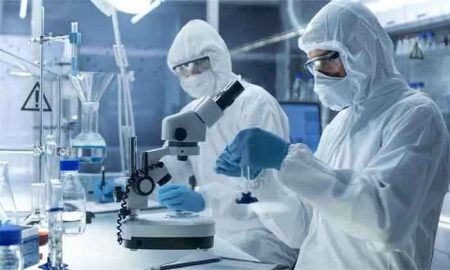
Refrigeration equipment can also be used in some electronics industries. For example, water chillers can stabilize some molecular structures inside electronic components and clean ultrasonic waves. Therefore, refrigeration equipment is also indispensable in the processing of the electronics industry.
3. Construction industry
The water chiller can stabilize the oil temperature and oil pressure. It can also be used in the construction industry to make some building materials have a good cohesive force and make the construction more convenient and effective.
4. Electroplating industry
During the electroplating process, the temperature needs to be kept at a certain fixed and stable temperature. The matching use of the chiller enables the production to achieve higher efficiency and stable quality.
5. Food processing
In many food industries, after the food is processed at high temperature, in order to be packaged quickly, the temperature of the food needs to meet the packaging requirements. At this time, it is necessary to use an industrial chiller to cool the processed food quickly and efficiently. fulfil requirements. In addition, in the process of food fermentation, different temperatures are also required to stabilize the needs of fermentation, so in order to ensure the quality of product fermentation, we also need to use chillers. In addition, chillers are also needed in the process of food preservation.
6. Pharmaceutical industry
In the pharmaceutical industry, it is mainly used to control the temperature control of fermented medicines. Pharmaceutical companies should make full use of chiller equipment, continue to strengthen technological innovation on the basis of giving full play to their advantages, and enhance the cost performance of chillers, so as to better serve the pharmaceutical sector.
7. Aquaculture
It is suitable for hotels, restaurants, seafood markets, aquariums, aquariums, aquaculture farms and other places that require fish pond water temperature.
8. Vacuum coating
Control the temperature of the vacuum coating machine to ensure the high quality of the coated parts.
9. Mechanical Industry
Control the pressure oil temperature of the oil pressure system, stabilize the oil temperature and oil pressure, prolong the service life of the oil quality, improve the efficiency of mechanical lubrication, and reduce wear and tear.
10. Chemical industry
It is mainly used for the cooling of chemical reaction kettles (chemical heat exchangers) to take away the huge heat generated by chemical reactions in time to achieve the purpose of refrigeration and improve product quality.
11. Automotive, semiconductor industry, etc.
How to install a chiller?
1. After receiving the equipment, the user first checks whether the parts of the machine are damaged and whether the screws are loose.
2. It should be installed in a place with a good surrounding environment and good ventilation. It is best to install it indoors, preferably in a computer room where the temperature does not exceed 45°C.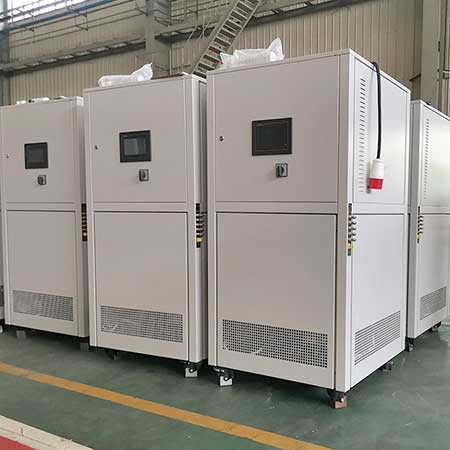
3. There should be enough space around the equipment for technicians to maintain and repair the equipment.
4. Select the water pipe with the appropriate diameter, the cooling system and the cold water system when the equipment is running at maximum power, and connect them correctly.
5. In order to reduce noise and vibration, it is better to install a vibration isolator on the pipeline.
6. Under any load conditions, the water flow should remain stable.
7. The design and installation of all cooling water pipes should be carried out in accordance with conventional methods. When piping, vibration damping pipes should be installed to ensure proper elasticity, and to prevent the water in the evaporator from being drained when the water pump stops.
8. Analyze the water quality to avoid fouling affecting the heat transfer effect. Please install a filter at the inlet of the water pipe and clean it regularly.
9. After the leak test is completed, all nozzles must be treated with anti-rust treatment.
How to maintain the chiller?
The maintenance of the chiller generally includes inspection, cleaning, alarm handling, regular maintenance, etc. of the refrigeration system equipment. There are the following suggestions for the maintenance of the chiller:
1. Conduct a standard and thorough inspection of the entire electric control and host circuit system of the chiller refrigeration system to ensure normal operation.
2. Trial run the chiller and perform a general calibration to test whether the heat is normal and whether there are abnormal noises in each component.
3. Check and correct the thermostat of the chiller to ensure that the thermostat displays normally.
4. Check and correct the high pressure and low pressure switches of the chiller, and make sure that the high and low pressures are within the normal range.
5. Carry out an insulation test on the compressor motor coil of the chiller.
6. Check the amount of refrigerant in the chiller, if not enough, replenish the refrigerant in time.
7. After the various protection devices of the chiller are set, they cannot be changed at will.
8. When the chiller is in normal operation, do not cut off the power supply and shut down the unit unless necessary.
9. In winter, if the chiller is not turned on for a long time, it is necessary to turn off the unit first, and then turn off the main power to drain the water in the chiller.
Common faults and troubleshooting methods of chillers
1. Power phase sequence failure
① Check whether the power supply is out of phase and ensure that the three-phase power supply is normal.
② Adjust any two phases of the power supply R/S/T until the phase sequence is normal.
2. Turn on the power switch, but the power indicator light of the chiller is not on
① If no fuse is installed, install an appropriate fuse.
②The power indicator light is damaged, replace the electronic board.
③The three-phase wiring of the power supply is wrong, check the wiring problem.
3. Turn on the power switch and water pump switch, the fuse is faulty
① circuit short circuit fault, check the control wire and main power wire.
②The water pump rotor is stuck, use a screwdriver to loosen the motor rotor.
4. Water pump failure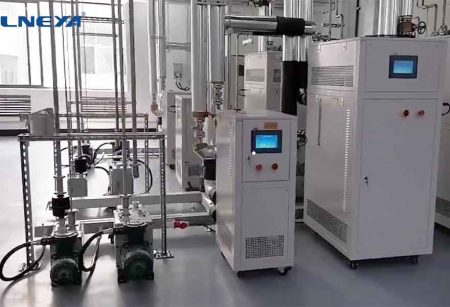
①Water pump motor coil is short or open circuit, repair the motor coil or replace the motor.
②The water pump overload protector trips automatically, adjust the current limit of the protector within the allowable range and press the reset button.
5. Compressor failure
①The compressor coil is broken or short circuited, replace the matching compressor.
②The compressor overload protector automatically trips, limits the current of the protector within the allowable range, adjusts it appropriately and presses the reset button.
6. The compressor is frosted
① If the circulation is not flowing or the valve is not opened, check the water valve and all pipelines to ensure smooth flow, and install a short-circuit pipeline.
② The configuration of the circulating water pipeline is too small, increase the diameter of the circulating water pipeline to ensure the normal water circulation.
7. The digital display of the temperature control meter jumps up and down
①The temperature control meter is damaged, repair or replace the temperature control meter.
②Poor contact of the temperature-sensing wire, repair or replace the temperature-sensing wire.
③The temperature sensing line and the temperature measuring body are dirty, wipe the temperature measuring body clean.
8. Freezing in the circulating water tank
①The set temperature is too low, correct the set value.
② There is no circulating water in the water tank, and a circulating water circuit is short-circuited between the chilled water outlet and the inlet.
③The temperature control meter is out of control, replace the temperature control meter.
8. High pressure failure of chiller
①Poor heat dissipation, the radiator is too dirty, the cooling water valve is not opened or opened too small, clean the radiator and fully open the valve.
②The high-pressure engine is damaged, replace the high-pressure engine.
③ Check whether the high-voltage control line is in poor contact or loose, and it should be connected properly.
9. Low voltage failure
① Insufficient refrigerant or pipeline leakage, supplement refrigerant or weld repair after leak detection.
② Check whether the low-voltage control line is poorly connected or loose, and it should be connected properly.
③ Check the damage of the press engine and replace it.
10. Poor cooling effect
Poor heat dissipation, the radiator is too dirty, the cooling water valve is not opened or opened too small, clean the radiator and fully open the valve.
 LNEYA
LNEYA
 简体中文
简体中文












































































